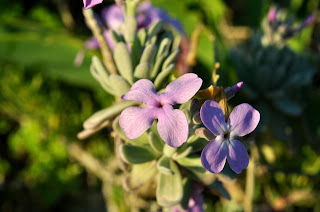The Maltese stocks is a special plant
because like the national plant (the Maltese centaury – Widnet il-baħar)
it is endemic to the Maltese islands. It is known in Maltese as Ġiżi ta’
Malta, because it not found growing wild in any other country.
The Maltese stocks is not considered as a separate species but as a subspecies flowers from March to May. Another race which is not indigenous to the Maltese islands, the garden stocks (Ġiżi komuni) was introduced in Malta as a garden plant but can be found growing wild in a number of areas especially on the fortifications at Valletta, Floriana, Tignè and Manoel Island.
The Maltese stocks is not considered as a separate species but as a subspecies flowers from March to May. Another race which is not indigenous to the Maltese islands, the garden stocks (Ġiżi komuni) was introduced in Malta as a garden plant but can be found growing wild in a number of areas especially on the fortifications at Valletta, Floriana, Tignè and Manoel Island.
The Maltese race was first described by a local and two foreign botanists in 1988.
It is a perennial plant belonging to the
mustard family. It is very rare in Malta but less rare in Gozo. It is an
endangered species and is protected by law.
Other species of stocks can be found in the
Maltese islands.
The Mediterranean stocks, known in Maltese as Gizi tal-baħar, is an annual plant with pale violet flowers. Until 20 years ago it grew mostly in disturbed ground along the extreme east coast of the Malta but has now spread to other areas especially along the Sliema, San Giljan and Baħar iċ-Ċagħaq coast and is much more common than it used to be.
The increase in range probably started by the dispersion of the seeds when a strong east wind blew them across the Grand Harbour to the other side of the Valletta peninsula from where it continued to expand its range further west.
This species has an interesting mode of dispersion as, when the seeds have become ripe, the plant breaks off at the base and tumbles in the wind leaving a trail of seeds along the way.
Another species is the night-scented stocks (ġiżi
tal-lejl) which is non-indigenous and rare. The Mediterranean stocks, known in Maltese as Gizi tal-baħar, is an annual plant with pale violet flowers. Until 20 years ago it grew mostly in disturbed ground along the extreme east coast of the Malta but has now spread to other areas especially along the Sliema, San Giljan and Baħar iċ-Ċagħaq coast and is much more common than it used to be.
The increase in range probably started by the dispersion of the seeds when a strong east wind blew them across the Grand Harbour to the other side of the Valletta peninsula from where it continued to expand its range further west.
This species has an interesting mode of dispersion as, when the seeds have become ripe, the plant breaks off at the base and tumbles in the wind leaving a trail of seeds along the way.
This species is of Eurasian origin and is often grown in gardens, especially in cooler regions, mainly for its pleasant scent which is most noticeable during the evening and at night.
This article was published in The Times on 21.03.2012

No comments:
Post a Comment